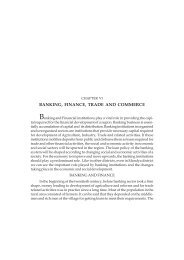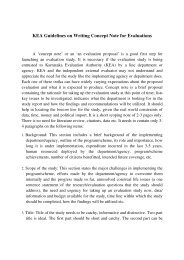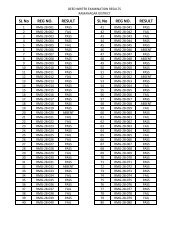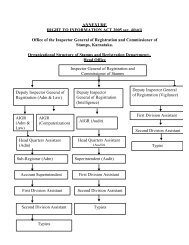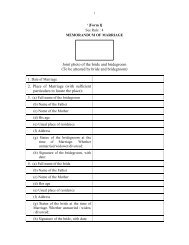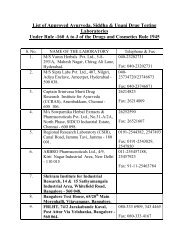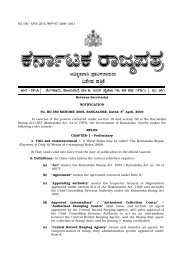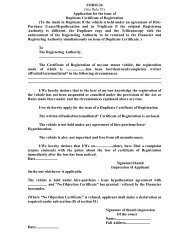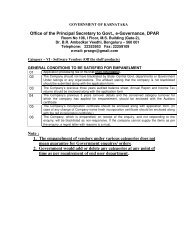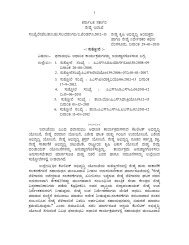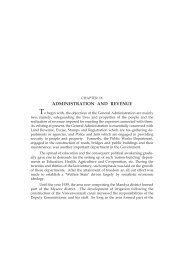Chapter XIII CULTURE - Government of Karnataka
Chapter XIII CULTURE - Government of Karnataka
Chapter XIII CULTURE - Government of Karnataka
You also want an ePaper? Increase the reach of your titles
YUMPU automatically turns print PDFs into web optimized ePapers that Google loves.
A Handbook <strong>of</strong> <strong>Karnataka</strong> 478<br />
wrote ‘Kavyavalokana’, a book on poetics, and ‘<strong>Karnataka</strong> Bhashabhushana’ a<br />
Kannada grammar in Sanskrit. His ‘Vardhamanapurana’ was discovered only<br />
recently. Janna, a Jain poet again, wrote ‘Yashodhara Charithe’, a romantic<br />
story. Durgasimha, in llth century, wrote ‘Panchatantra’ based on Vasubhaga’s<br />
Sanskrit work, and it is a classic example <strong>of</strong> the ancient art <strong>of</strong> story telling.<br />
Rudrabhatta wrote ‘Jagannatha Vijaya’ based on ‘Vishnu Purana’, The last two<br />
were Brahmin poets.<br />
The 12th century saw a sea <strong>of</strong> change in Kannada literature both in content<br />
and style. What caused this is the growth <strong>of</strong> Veerashaivism which was essentially<br />
revolutionary in approach. It derecognised untouchability and saw women as<br />
equals. It liberated Kannada from the clutches <strong>of</strong> Sanskrit. The moving spirit<br />
behind this movement was Basaveshwara, who was a minister in the court<br />
<strong>of</strong> Prince Bijjala. His Vachanas which can be called prose-poems, have their<br />
origin in folk-literature and folk-culture, and yearn to liberate man from the<br />
bondage <strong>of</strong> untruth and ignorance. They seek to provide happiness here and<br />
elsewhere. Allamaprabhu, Akkamahadevi, Channabasavanna, Siddarama,<br />
Madivala Machayya, Dohara Kakkayya, etc., were other Vachanakaras <strong>of</strong> the<br />
period.<br />
After Basavanna, the greatest influence on Kannada literature was<br />
Harihara, who used an innovative form called ‘Ragale’. His ‘Basavarajadevara<br />
Ragale’ and ‘Nambiyannana Ragale’ are the examples <strong>of</strong> this genre. His nephew<br />
Raghavanka introduced yet another form <strong>of</strong> poetry called ‘Shatpadi’ and apart<br />
from ‘Somanatha Charithe’ and ‘Siddarama Charithe’ his ‘Harischandra Kavya’<br />
is considered to be a masterpiece.<br />
The Sixteenth Century saw Veerashaiva poets <strong>of</strong> extraordinary merit.<br />
Sarvajna who was real Vairagi in that he had no settled home, and no religion,<br />
wrote “Sarvajna Padagalu’ in Tripadi style. This work is really a compendium<br />
<strong>of</strong> wit and wisdom. Nijaguna Sivayogi who was a ruler, saint and scholar wrote<br />
‘Viveka Chintamani’ an encyclopedia in Kannada.<br />
Dasakoota or the Vaishnava movement was led by Purandara Dasa, who<br />
is also considered the father <strong>of</strong> Karnatic music. Through his Keerthanas, he<br />
propounded the Dwaitha Philosophy and gave an impetus to Bhakthi movement.<br />
Kanaka Dasa, though hailing from the Kuruba community, followed in the<br />
footsteps <strong>of</strong> Purandara Dasa. He is credited with several Keertanas, being the<br />
author <strong>of</strong> Mohanatarangini, Ramadhanya charite.<br />
<strong>Karnataka</strong> culture reached its zenith during the Vijayanagara empire.<br />
Naranappa’s (Kumaravyasa) ‘<strong>Karnataka</strong> Bharatha Kathamanjari’ or ‘Gadugina<br />
Bharatha’ as it is popularly known is the finest example <strong>of</strong> the literature <strong>of</strong> this<br />
period. This was followed by Lakshmisha’s ‘Jaimini Bharatha’ which is also<br />
an immensely popular work. Chamarasa’s ‘Prabhulingalile’ is another notable<br />
work <strong>of</strong> this period.<br />
Post-renaissance movement saw a four-lined folk-metre called ‘Sangatya’<br />
which was particularly suitable for singing. Nanjundakavi who wrote



